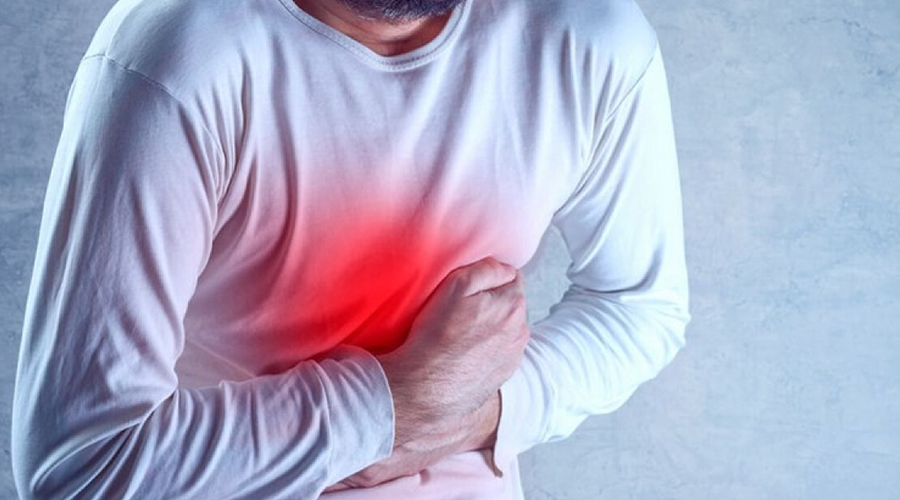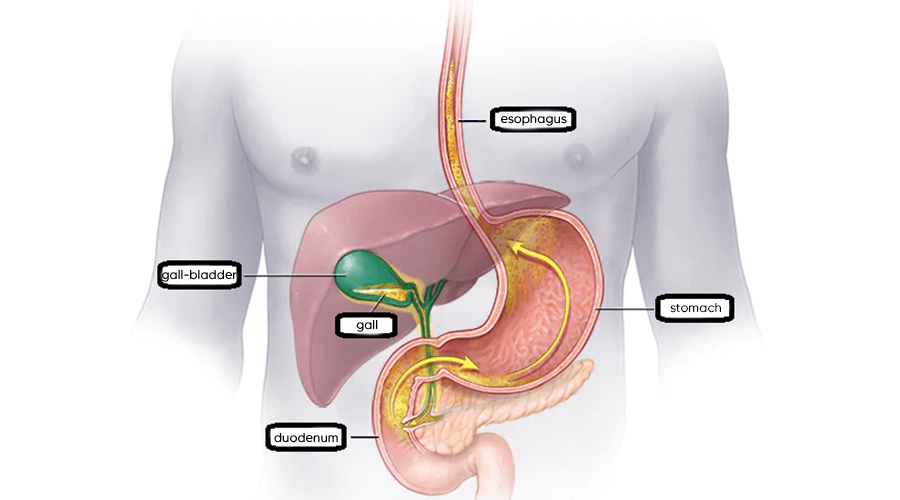
In case of biliary spasm, excellent choleretic mineral waters (Mira, Salvus) are available, which can relieve complaints. Bile spasm treatment is also possible at home, for which we now offer several options.
How can bile spasm be alleviated?
You can help with milder complaints with remedies that stimulate the activity of the liver and gall bladder. Teas, drops and other preparations made from herbs can help a lot in the treatment of bile complaints. Black radishes can be of great help against cholespasm at home. Folk medicine, for example, has long used fresh black radish to stimulate bile and liver function. Small gallstones can also be dissolved with freshly squeezed juice.
Where is the bile?
Bile is produced in the liver in the human body and then flows into the gallbladder through the bile ducts of the liver. The gallbladder is a small organ located below the liver, located on the right side of the abdominal cavity, below the liver, below the ribs. The function of the gallbladder is to store and concentrate bile. When bile is needed during digestion, the gallbladder empties bile through the bile duct into the digestive system, a section of the small intestine called the duodenum. Bile plays an important role in digestion in breaking down and absorbing fats.
Where does the bile hurt?
Bile spasm, i.e. pain in the gallbladder or bile ducts, usually occurs in the upper right abdominal area. The gallbladder is located below the liver, under the right rib cage, and the bile ducts lead from the gallbladder to the small intestine. Gallbladder pain is usually felt in the right upper abdomen, under the liver, around the right rib cage, and can often radiate to the back, right shoulder, or right shoulder blade.

The location of the bile
What should I do if I have gallstones?
Bile spasm is a painful condition that occurs when a gallstone in the gallbladder blocks the bile ducts. In such a case, the following is recommended:
– Rest
– Warm poultice
– Fluid intake
– Painkillers
– Seeking medical help
What else is good for gallstones?
There are many medicinal herbs for gallstone pain, which can be used to support the work of the liver and gall bladder by consuming their decoction. Bile pain is mostly treated at home with the help of herbs, but tea and different tea mixtures can also be used for biliary spasm. St. John’s Wort and Dandelion primarily act as antispasmodics on the bile duct sphincter, so that bile can flow unhindered. These plants also prevent the bile produced in the liver from thickening in the bile ducts and gall bladder. This keeps the bile diluted and reaches the small intestine more easily. Turmeric and artichokes stimulate liver cells to produce more bile. The artichoke also contains cell-protective flavonoids that reduce the effects of liver-damaging substances. With tea made from milk thistle, you can not only improve the general condition of the liver, but also support its bile-producing function. Dandelion and field catang are also excellent for prevention, because they enhance liver function, stimulate digestion and bile production. In the case of bile spasms, you can also choose lemongrass, peppermint, yarrow, as well as peppermint, fustica, chamomile herbs, or a mixture of them.
Be careful, because in the case of acute cholecystitis, teas that stimulate bile activity can have the exact opposite effect, because with increased bile activity, you only increase the pressure in the gallbladder.
How long does inflammation of the gallbladder last?
The duration of inflammation of the gallbladder (cholecystitis) depends on several factors, such as the severity of the condition, the way it is treated, and the individual’s health. Gallbladder inflammation can be acute or chronic.
Acute cholecystitis usually begins suddenly and may require immediate medical attention.
Chronic cholecystitis develops over a longer period of time and may have milder symptoms.
The duration of gallbladder inflammation is determined by medical treatment, the severity of the condition, and individual factors.
There are still great medicinal teas against gallstones
Bile pain relief can be done at home with the help of the following herbal teas. First of all, the nettle leaf is considered one of the best cleansing plants, it can also relieve bile spasm. It is able to dissolve metabolic waste products. It removes toxins from the body, which makes it very suitable for biliary spasm. Bile pain relief is also possible with the help of tea made from nettle leaves. It is also used for liver and stomach problems. Its high iron content also helps a lot in blood formation. Medicinal tea made from it is mainly used for liver and bile problems. It stimulates the kidneys and lowers the level of uric acid in the blood. In spring and autumn, it is recommended to do a course with it, which should last 6 weeks.
Medicinal tea made from walnut leaves also has a great effect if the goal is to relieve bile pain. It is also excellent for digestive problems and diarrhea. It stimulates the functioning of the liver, increases blood circulation and also removes waste products. It improves digestion, so it is recommended to consume it after meals.
The herb called goldenrod stimulates the production of bile and cleans the bile and the liver. It also plays a huge role in digestion. If you are overloading your stomach, this can be an excellent help.
Field katáng has a great digestive, choleretic, diuretic and body-cleansing effect. It helps the gallbladder to empty completely, but it also cleans the liver, spleen and kidneys. It also helps with ideal bowel function. The medicinal tea made from it should only be consumed as a cure. It is recommended to drink 1 cup in the morning on an empty stomach for 1 week, in the second week only every other day, and in the third week every third day. It is enough to carry out such a choleretic treatment twice a year.
So, as you can see, it is also possible to induce bile at home, with the help of herbal teas, of course.
It is best to treat gallstones at home with the herbs mentioned above. However, it is important to know that gallstones can recur, which is why surgery is usually recommended in many cases. Recurrence can also be prevented with a diet, the main rule of which is that it is not recommended to eat high-fat or excessively spicy foods. In the case of gallstones, it is important to drink plenty of fluids, preferably only water.
However, the immediate relief of bile spasm is not so simple. First of all, it is very important to eat only low-fat foods in case of cramps. Bile plays a very important role in the digestion of fats, so fatty foods contribute to making bile spasms more painful. Dandelion tea is the best and fastest solution. It acts as an antispasmodic on the sphincter muscle of the bile duct, so bile can flow unhindered. If we struggle with regular bile complaints, dandelion tea is essential in our home pharmacy.
What should be done in case of gallstones?
Consumption of the herbal teas mentioned above, (dandelion is best in case of spasms), externally warm poultices, and massage can help. In addition to herbal teas, there are also several herbal extract bile spasm medicines available, which are often made from the above-mentioned herbs. However, you should also know that biliary spasm can even indicate an inflammatory condition, so it is definitely worth seeing a doctor in case of a long-lasting complaint.
In the case of biliary spasm symptoms, the most significant is an intense, even stabbing pain in the middle or upper right part of the abdomen, which can radiate to the shoulder, chest and shoulder blade. The pain can be stabbing, sharp, or cramping. In addition, nausea, vomiting, sweating, bloating, a feeling of fullness, heartburn, and frequent belching may also occur.
Where does the bile spasm hurt, in which part of the body does the pain occur?
Bile spasm occurs mainly in the area of the gallbladder, where bile is stored. The affected area is below the right rib, usually in the upper right abdomen.
How long does a bile spasm last?
Bile spasms are usually short-lived, but generally speaking, they can last from a few minutes to a few hours. In rarer cases, bile spasm can last for days. Biliary spasm usually occurs suddenly and is accompanied by severe pain, but it is also possible that the symptoms are milder and last for a shorter time.
The nocturnal bile spasm
Nocturnal biliary spasm is an unpleasant and painful condition that can develop due to gallstones in the gallbladder or stones in the bile ducts. Symptoms of nocturnal biliary spasm usually occur at night when a person is at rest and the body is in a horizontal position.
Symptoms may include:
Pain: The most common symptom of nocturnal biliary spasm is intense pain. It usually occurs in the area under the right rib cage, at the location of the gallbladder, and can be sharp, stabbing or spasmodic. The pain can radiate to the back, neck, shoulder and even the right arm.
Nausea and vomiting: Nocturnal bile spasms can usually cause nausea and vomiting.
Heartburn and Bloating: Due to nocturnal biliary spasm, patients may also experience heartburn and bloating.
Fever and chills: In more severe cases, nocturnal bile spasm can be accompanied by fever and chills.
Fast pulse and high blood pressure: Nocturnal bile spasms can cause the heart to beat faster and blood pressure to rise.
What foods cause gallstones?
Bile spasm is usually caused by bile accumulated in the gallbladder, but food can also contribute to the development of symptoms. Bile spasm can be triggered mainly by fatty, heavy and spicy foods, as well as alcohol and caffeine, but smoking can also be mentioned.
What are choleretic foods?
Bile diluting foods are foods that help produce bile or increase the emptying of bile from the gallbladder.
Cabbage: Different types of cabbage, such as white cabbage, red cabbage and sauerkraut, can help with bile production and bile flow due to their high fiber content.
Beets: Beets are rich in antioxidants and fiber, which can support gallbladder and bile duct health and promote bile flow.
Green Leafy Vegetables: Vegetables such as spinach, Swiss chard and broccoli can support bile production and bile flow due to their high fiber content.
Citrus fruits: Citrus fruits, such as lemons and grapefruit, are rich in vitamin C, which can promote gallbladder and bile duct health.
Apple: The high fiber content of apples can promote bile production and bile flow.
Oily seeds: Oily seeds, such as flaxseeds, walnuts, and almonds, contain healthy fats that can help produce bile.


